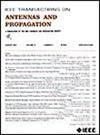Electromagnetic Effects Analysis for Biological Tissues via Dispersive FCC-FDTD Method
IF 5.8
1区 计算机科学
Q1 ENGINEERING, ELECTRICAL & ELECTRONIC
引用次数: 0
Abstract
A dispersive face-centered cubic finite-difference time-domain (FCC-FDTD) method is proposed for analyzing electromagnetic effects in biological tissues in this article, where biological tissues are dispersive media described by the Debye model. To simplify the derivation and improve accuracy, the auxiliary differential equation (ADE) technique is incorporated into the FCC-FDTD method updating formulas, and the convolutional perfect matched layer (CPML) for the dispersive FCC-FDTD method is developed. Then, the stability of the dispersive FCC-FDTD method is investigated for solving the four-term Debye dispersive model. Three numerical examples, pulse propagation in Debye medium, pulse propagation in multimedia, and the electromagnetic energy absorption of the four-layer spherical head phantom, are used to validate the performance of the dispersive FCC-FDTD method. Considering the dispersive properties of biological tissues, the proposed method is used to analyze the electromagnetic effects of the human brain under broadband radiation. The results show that there are differences in the absorption of electromagnetic energy for different biological tissues, and the electromagnetic effects of the human brain are influenced by age and gender. As a result, the proposed method can more accurately evaluate the effects that electromagnetic radiation causes on organisms and serve as a reference for their electromagnetic safety to make further targeted protection research.基于色散FCC-FDTD的生物组织电磁效应分析
本文提出了一种色散面心三次时域有限差分(FCC-FDTD)方法来分析生物组织中的电磁效应,其中生物组织是用Debye模型描述的色散介质。为了简化推导和提高精度,将辅助微分方程(ADE)技术引入FCC-FDTD方法更新公式中,并开发了色散FCC-FDTD方法的卷积完美匹配层(CPML)。然后,研究了色散FCC-FDTD方法求解四项Debye色散模型的稳定性。通过脉冲在德拜介质中的传播、脉冲在多媒体中的传播以及四层球头模体的电磁能量吸收三个数值算例验证了色散FCC-FDTD方法的性能。考虑到生物组织的色散特性,采用该方法分析了宽带辐射下人脑的电磁效应。结果表明,不同生物组织对电磁能量的吸收存在差异,人脑的电磁效应受年龄和性别的影响。因此,该方法可以更准确地评价电磁辐射对生物体的影响,为进一步开展有针对性的电磁安全防护研究提供参考。
本文章由计算机程序翻译,如有差异,请以英文原文为准。
求助全文
约1分钟内获得全文
求助全文
来源期刊
CiteScore
10.40
自引率
28.10%
发文量
968
审稿时长
4.7 months
期刊介绍:
IEEE Transactions on Antennas and Propagation includes theoretical and experimental advances in antennas, including design and development, and in the propagation of electromagnetic waves, including scattering, diffraction, and interaction with continuous media; and applications pertaining to antennas and propagation, such as remote sensing, applied optics, and millimeter and submillimeter wave techniques

 求助内容:
求助内容: 应助结果提醒方式:
应助结果提醒方式:


